
(a)
Interpretation:
The HOMO of one reactant and LUMO of the other reactant in the given reaction are to be drawn assuming one of the reactants is in its lowest excited state.
Concept introduction:
The bonding or antibonding character of an MO is determined by the number of constructive and destructive interactions. When the number of constructive (same phase) interactions exceed the number of destructive interactions, the MO is bonding. If the number of destructive interactions is larger, the MO is antibonding.
The highest energy bonding MO is the last one that contains electrons and is called the Highest Energy Molecular orbital (HOMO). The antibonding MO immediately above it in is the Lowest Energy Unoccupied Molecular Orbital, called LUMO.
For the molecule in its lowest excited state, one of the electrons from the ground state HOMO is promoted to the ground state LUMO. Therefore, the LUMO of the ground state, the first of the antibonding MOs now becomes the HOMO, and the LUMO is the second antibonding MO.
Answer to Problem 24.62P
The HOMO of one reactant and the LUMO of the other reactant for the three reactions are
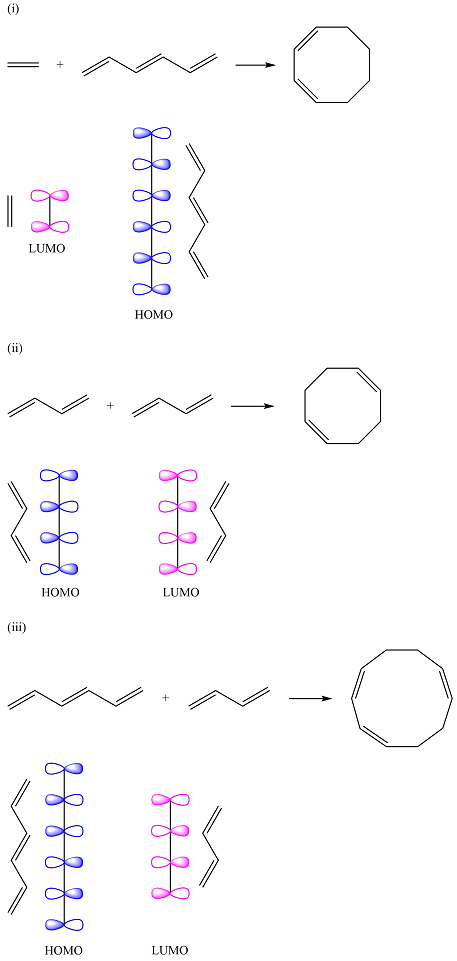
Explanation of Solution
Reaction (i) is

Assuming the larger reactant to be the diene in its lowest excited state, i.e., the donor molecule in the Diels-Alder reaction, the HOMO of was determined by considering the different interactions between the six p orbitals of the carbons. The possible interactions are
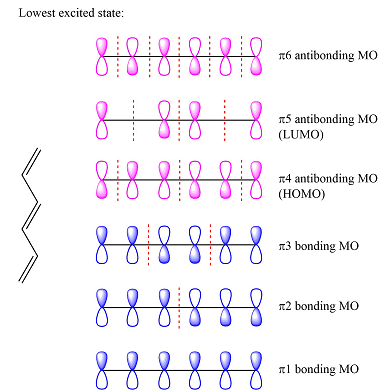
With three
The smaller of the reactants has only two carbons and one

Thus, the HOMO and LUMO for this reaction are:
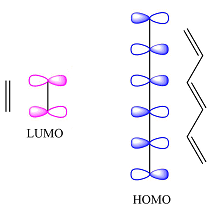
Reaction (ii) is

The reactants are the same. They both have four carbons, and therefore, p orbitals. The interaction of these will result in four
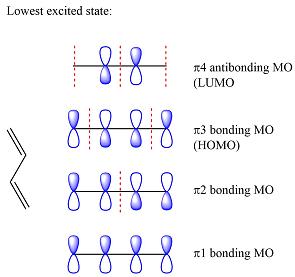
The MOs of the other molecule remain the same as in the ground state
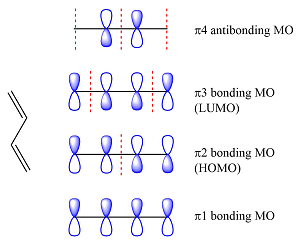
Thus, the HOMO and LUMO in this case are
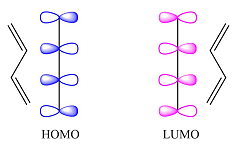
Reaction (iii) is

The first reactant has six carbons that contribute six p orbitals. The six
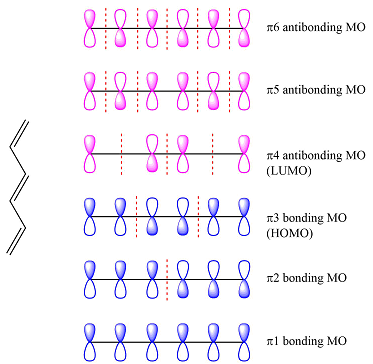
Assuming this molecule is in the lowest excited state, one of the electrons from its ground state HOMO (
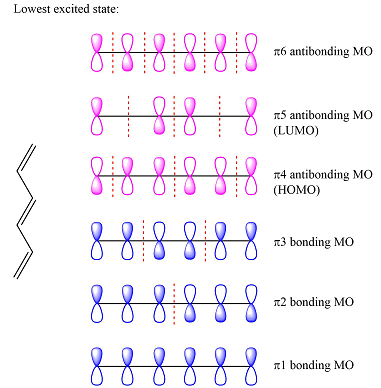
The second reactant has four carbons that contribute four p orbitals. The four
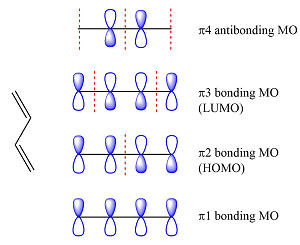
Again, assuming that the larger molecule acts as the donor (diene) and the smaller as the acceptor (dienophile) molecule, the HOMO and LUMO that interact in the Diels-Alder reaction are
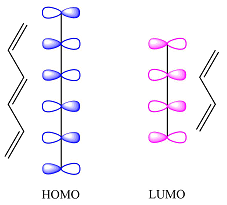
The
(b)
Interpretation:
The HOMO-LUMO interaction between the two reactants is to be drawn and if it will result in a thermally allowed or forbidden reaction is to be determined.
Concept introduction:
Diels-Alder reaction is a concerted reaction between a diene and a dienophile that produces a cyclic compound. It replaces two
In terms of MO theory, the reaction requires that the overlapping orbitals of the two molecules be in phase so that constructive interference occurs.
The electron flow starts with the diene donating a pair of
Answer to Problem 24.62P
The HOMO-LUMO interactions for the three reactions are:
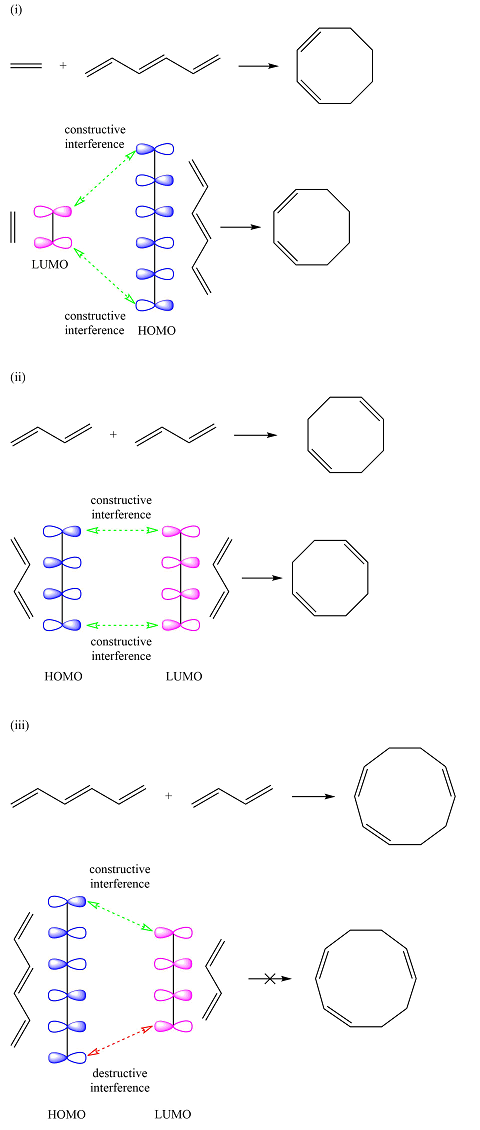
Reactions (i) and (ii) are thermally allowed reactions. Reaction (iii) is a thermally forbidden reaction.
Explanation of Solution
Reaction (i) is

Based on the HOMO and LUMO from part (a), the HOMO-LUMO interaction for this reaction is
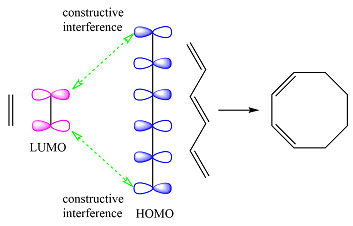
Both interactions are constructive. The net result is, therefore, a bonding interaction. Therefore, the reaction is thermally allowed.
Reaction (ii) is

Based on the HOMO and LUMO from part (a), the HOMO-LUMO interaction for this reaction is
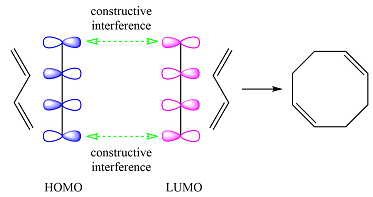
Both interactions are constructive. The net result is, therefore, a bonding interaction. Therefore, the reaction is thermally allowed.
Reaction (iii) is

Based on the HOMO and LUMO from part (a), the HOMO-LUMO interaction for this reaction is
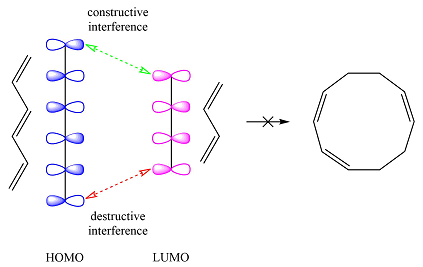
One of the interactions is constructive while the other is destructive, i.e., the net interaction is zero. Therefore, this reaction is thermally forbidden.
The HOMO-LUMO interaction between the reactants is determined based on the overlap and phases of the donor and acceptor MOs respectively and the feasibility of the reaction determined from the overall character of the interaction.
Want to see more full solutions like this?
Chapter 24 Solutions
EBK GET READY FOR ORGANIC CHEMISTRY
- A certain inorganic cation has an electrophoretic mobility of 5.27 x 10-4 cm2s-1V-1. The same ion has a diffusion coefficient of 9.5 x 10-6cm2s-1. If this ion is separated from cations by CZE with a 75cm capillary, what is the expected plate count, N, at an applied voltage of 15.0kV? Under these separation conditions, the electroosmotic flow rate was 0.85mm s-1 toward the cathode. If the detector was 50.0cm from the injection end of the capillary, how long would it take in minutes for the analyte cation to reach the detector after the field was applied?arrow_forward2.arrow_forwardPlease solve for the following Electrochemistry that occursarrow_forward
- Commercial bleach contains either chlorine or oxygen as an active ingredient. A commercial oxygenated bleach is much safer to handle and less likely to ruin your clothes. It is possible to determine the amount of active ingredient in an oxygenated bleach product by performing a redox titration. The balance reaction for such a titration is: 6H+ +5H2O2 +2MnO4- à 5O2 + 2Mn2+ + 8H2O If you performed the following procedure: “First, dilute the Seventh Generation Non-Chlorine Bleach by pipetting 10 mL of bleach in a 100 mL volumetric flask and filling the flask to the mark with distilled water. Next, pipet 10 mL of the diluted bleach solution into a 250 mL Erlenmeyer flask and add 20 mL of 1.0 M H2SO4 to the flask. This solution should be titrated with 0.0100 M KMnO4 solution.” It took 18.47mL of the KMnO4 to reach the endpoint on average. What was the concentration of H2O2 in the original bleach solution in weight % assuming the density of bleach is 1g/mL?arrow_forward10.arrow_forwardProper care of pH electrodes: Why can you not store a pH electrode in distilled water? What must you instead store it in? Why?arrow_forward
- Write the electron configuration of an atom of the element highlighted in this outline of the Periodic Table: 1 23 4 569 7 He Ne Ar Kr Xe Rn Hint: you do not need to know the name or symbol of the highlighted element! §arrow_forwardIdentify the amino acids by name. Illustrate a titration curve for this tetrapeptide indicating the pKa's for each ionizable groups and identify the pI for this tetrapeptide. please helparrow_forward↓ ina xSign x Sign X labs X Intro X Cop Xa chat X My Cx Grac X Laur x Laur xash learning.com/ihub/assessment/f188d950-dd73-11e0-9572-0800200c9a66/d591b3f2-d5f7-4983-843c-0d00c1c0340b/f2b47861-07c4-4d1b-a1ee-e7db2 +949 pts /3400 K Question 16 of 34 > © Macmillan Learning Draw the major E2 reaction product formed when cis-1-chloro-2-ethylcyclohexane (shown) reacts with hydroxide ion in DMSO. H CH2CH3 H H HO- H H H Cl DMSO H H C Select Draw Templates More C H 0 2 Erasearrow_forward
- A common buffer for stabilizing antibodies is 100 mM Histidine at pH 7.0. Describe the preparation of this buffer beginning with L-Histidine monohydrochloride monohydrate and 1 M NaOH. Be certain to show the buffering reaction that includes the conjugate acid and base.arrow_forwardFina x | Sign X Sign X lab: X Intro X Cop) X a chat x My x Grad xLaur x Laur x a sheg X S Shoj XS SHE X acmillanlearning.com/ihub/assessment/f188d950-dd73-11e0-9572-0800200c9a66/d591b3f2-d5f7-4983-843c-0d00c1c0340b/f2b47861-07c4-4d1b-a1ee-e7db27d6b4ee?actualCourseld=d591b3f2- 5 © Macmillan Learning Organic Chemistry Maxwell presented by Macmillan Learning For the dehydrohalogenation (E2) reaction shown, draw the Zaitsev product, showing the stereochemistry clearly. H H KOH Br EtOH Heat Select Draw Templates More Erase // C H Q Search hp Q2 Q Δ קו Resouarrow_forwardIs the structural form shown possible given the pKa constraints of the side chains?arrow_forward
 ChemistryChemistryISBN:9781305957404Author:Steven S. Zumdahl, Susan A. Zumdahl, Donald J. DeCostePublisher:Cengage Learning
ChemistryChemistryISBN:9781305957404Author:Steven S. Zumdahl, Susan A. Zumdahl, Donald J. DeCostePublisher:Cengage Learning ChemistryChemistryISBN:9781259911156Author:Raymond Chang Dr., Jason Overby ProfessorPublisher:McGraw-Hill Education
ChemistryChemistryISBN:9781259911156Author:Raymond Chang Dr., Jason Overby ProfessorPublisher:McGraw-Hill Education Principles of Instrumental AnalysisChemistryISBN:9781305577213Author:Douglas A. Skoog, F. James Holler, Stanley R. CrouchPublisher:Cengage Learning
Principles of Instrumental AnalysisChemistryISBN:9781305577213Author:Douglas A. Skoog, F. James Holler, Stanley R. CrouchPublisher:Cengage Learning Organic ChemistryChemistryISBN:9780078021558Author:Janice Gorzynski Smith Dr.Publisher:McGraw-Hill Education
Organic ChemistryChemistryISBN:9780078021558Author:Janice Gorzynski Smith Dr.Publisher:McGraw-Hill Education Chemistry: Principles and ReactionsChemistryISBN:9781305079373Author:William L. Masterton, Cecile N. HurleyPublisher:Cengage Learning
Chemistry: Principles and ReactionsChemistryISBN:9781305079373Author:William L. Masterton, Cecile N. HurleyPublisher:Cengage Learning Elementary Principles of Chemical Processes, Bind...ChemistryISBN:9781118431221Author:Richard M. Felder, Ronald W. Rousseau, Lisa G. BullardPublisher:WILEY
Elementary Principles of Chemical Processes, Bind...ChemistryISBN:9781118431221Author:Richard M. Felder, Ronald W. Rousseau, Lisa G. BullardPublisher:WILEY





